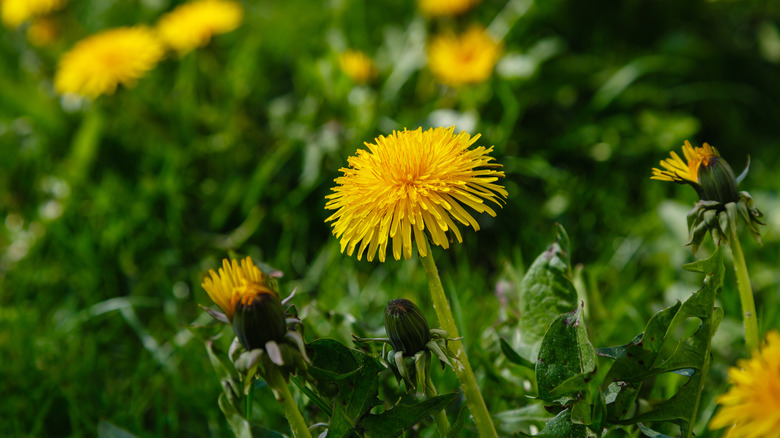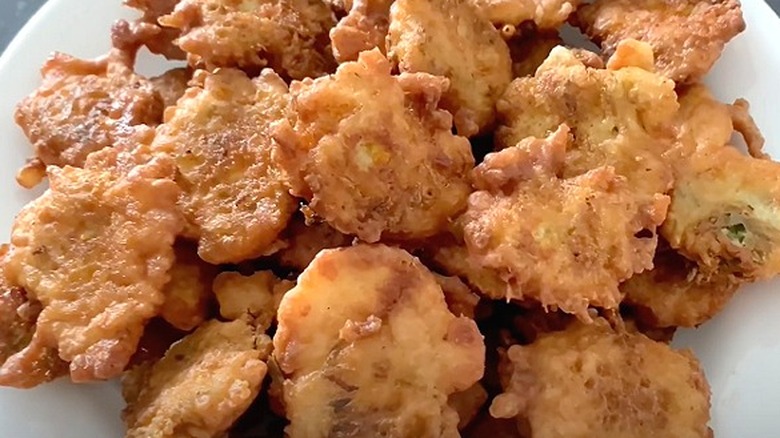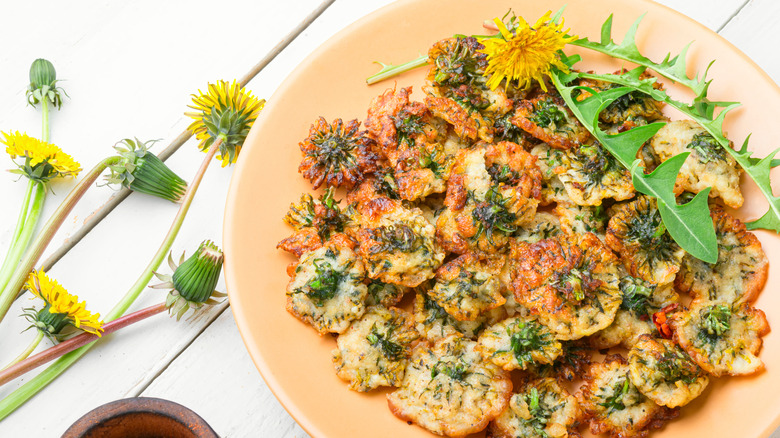How Appalachian Cooks Prep Dandelions For Crispy Sandwiches
If you're a fan of foraging, as in scouring Mother Earth for delicious and free edible morsels, this next sentence may elicit a mere shrug: You can, and should, eat dandelion flowers! We're not talking about those toothy leaves known as dandelion "greens," well-known for perking up salads and stir-fries with a touch of tangy flavor. We're referring to the little yellow blossoms perched atop the Taraxacum officinale plant, aka the common dandelion. They've long been considered weeds in many parts of the United States. One community, in particular, is way ahead of the curve on this one — the people of the Appalachian Mountain range.
In addition to embracing dandelion greens, Appalachian foragers, chefs, and home-kitchen cooks have some time-honored traditions for making delicious, nutritious, crispy sandwiches featuring one of the most seasonally accessible flowers in Mother Nature's worldwide garden. But there's a trick to prepping dandelion flowers for crunchy, munchy goodness, one that essentially comes down to a big-ole frying pan, some hot oil or butter, an egg or two, and dozens of little lovelies drenched in flour.
Recipes vary slightly across Appalachia, which spans 13 states and 206,000 square miles. With at least half of those states belonging to the "American South," it's not surprising to find one thing in common: those fresh open-field or backyard dandelions are likely deep-fried to golden perfection before nestling between two slices of sandwich bread.
Dandelion flowers in a crispy fried fritter
Preparing dandelion flowers for sandwich success is similar to making fried chicken. But rather than heading to the poultry section of a supermarket, you'll be stepping into your own backyard, an open meadow, or a local park. Dandelions grow prolifically in May and June but can thrive in long days of summer through autumn. That's plenty of foraging time and loads of blossoms for the taking.
After plucking dandelions from the ground, remove the flowers from the stems and leaves. Save the dandelion greens for other recipes, but you don't need them here. Separate the yellow blossom from the green stem at its base, known as the outer bract. Though edible, it can leave a bitter taste in your mouth. Keep the inner bract intact to hold the petals together. The Appalachian way tends to be simple, though you can always season or add ingredients to taste. You're basically making a fritter or patty that will end up inside the sandwich.
Before the deep-fry fun, brine the dandelions in cold salted water for about 30 minutes, then rinse to ensure no dirt or sediment remains. Now you'll toss the flowers in flour, coating well, and then add one or two beaten eggs to hold the flour and blossoms together. Mix well, adding salt and pepper to taste, and form into patties. Pan-fry each one in melted butter or cooking oil, flipping to ensure each side turns golden brown.
Tips and info on edible dandelion flowers
Some variations on fried dandelion flowers could take you in new directions, while still holding true to Appalachian techniques. For example, rather than forming the battered flowers into fritters, try frying each flower separately. It holds the pretty floral shape and works well as party appetizers. But they're also perfect for semi-enclosed pita-bread sandwiches or thin flatbread wraps.
Apart from the crave-worthy fried crispness, dandelion flowers also happen to carry plenty of health benefits. They're a good source of antioxidants and rich nutrients such as vitamins A, C, and B12, as well as iron, calcium, magnesium, and potassium. From healthy skin to reduced indigestion and boosting the immune system, there's a lot going on when you bite into that crispy Appalachian-style dandelion sandwich.
Dandelions growing in the wild may require a bit of due diligence since they aren't subject to commercial food-chain regulations. First, be familiar with the characteristics of a true dandelion. It'll have only one flower on each stalk, and the stem will be tubular and hollow. The leaves, though spiky in appearance, will actually sport a smooth rather than "hairy" texture.
If at all possible, avoid edible flowers growing in areas known to receive pesticide or herbicide treatments. Check for signs of "spray" from wild or domestic animals as well. At the very least, wash thoroughly before battering and cooking.



